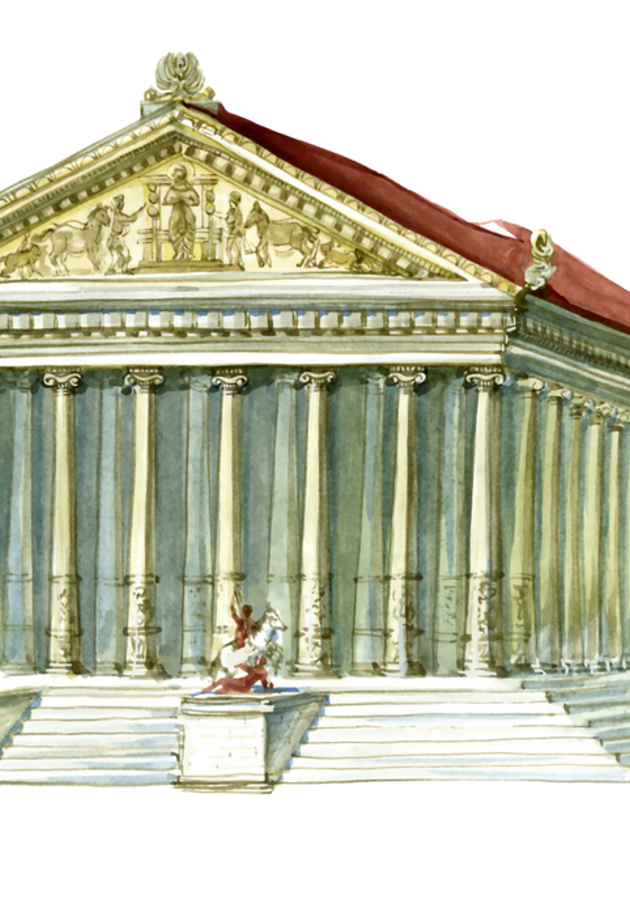When Helena Bonham Carter was cast to play Princess Margaret in season three of the exceptional Netflix TV show “The Crown,” one of the first things she did was visit 87-year-old Lady Anne Glenconner. The reason? For 30 years, Glenconner was Princess Margaret’s Lady in Waiting. Yes, she appeared in “The Crown” as well, played excellently by British actress Nancy Carroll; and yes, “Lady in Waiting” is Glenconner’s tell-all memoir. So, get ready to learn more about how living in the shadow of the crown looks in real life and whether it is as fancy as you might have imagined it!
Disinherited at birth
Anne Coke Tennant, Baroness Glenconner, was born on July 16, 1932 into an ancient British family, their lineage spanning all the way back to the last days of the Tudors. The family’s founding father, Sir Edward Coke (pronounced “cook”), successfully prosecuted Sir Walter Raleigh and the Gunpowder Plot conspirators and is remembered by history as the greatest jurist of the Elizabethan and Jacobean era. One of his descendants, Thomas Coke, the first Earl of Leicester, commissioned the design and construction of the majestic Holkham Hall in north Norfolk, the fifth largest estate in England. It was there that Anne was born and spent the idyllic years of her early childhood.
She was a honeymoon baby, arriving on the first wedding anniversary of her parents, Thomas Coke, the future fifth Earl of Leicester, and Lady Elizabeth Yorke, daughter of the eighth Earl of Hardwicke. After Anne came two more sisters: Carey, in 1934, and Sarah, a decade later. Their sex meant that neither would be allowed to inherit Holkham Hall – or the Earldom, for that matter. “The line was broken,” Anne writes, “and my father must have felt the weight of almost four centuries of disapproval on his conscience.”
She was seven years old when the Second World War broke out. Thomas Coke and Lady Elizabeth left Norfolk for Egypt and sent Anne and Carey to live with their Ogilvy cousins in Scotland. There, she had to endure the whims and cruelty of a mean governess named Miss Bonner who would punish her by tying her hands to the back of the bed and leaving her like that all night. Years later, when Miss Bonner sent Anne a card congratulating her on her engagement, the very sight of her handwriting triggered “the most unpleasant rush of memories” in Anne’s heart and head and made her “physically sick.”
Treasured manuscripts and cheap hotels
In 1944, the Coke family was reunited at Holkham. There, Anne’s grandfather put her in charge of airing the Codex Leicester, Leonardo da Vinci’s 72-page manuscript, a study on water and stars. “I used to lick my finger and spin through the pages,” remembers Anne, “frowning down at Da Vinci’s mirror handwriting, studying the little drawings and diagrams with interest.” Unfortunately, not long after, her father had to sell the Codex to keep up the estate. In 1994, the Codex became the most valuable book in the world when it was bought by Bill Gates for more than $30 million at a New York auction. “It’s still covered with my DNA,” smirks Anne.
In 1948, aged 16, Anne finished school. There was never even a consideration if she should go on to university. Due to a lack of money, she didn’t even get a chance to go abroad. Instead, like all of her friends, she was sent off to the first of her two finishing schools, Powderham Castle. There, Anne explains, “twenty-five girls per year were taught how to run a big house – their big house – under the guise of what was called ‘domestic economy’.” In practice, that meant making drop scones, arranging flowers and learning to perfect conversation skills. By the time Anne completed the course in 1949, her grandfather died and her father succeeded to his title, becoming the fifth Earl of Leicester.
Money was still pretty tight during these years, and Lady Elizabeth had to set up a pottery at Holkham. Curiously, it proved a commercially successful endeavor. Since Anne wasn’t artistically gifted, she asked her mother if she could sell the pots. Almost straight away, off Anne set “in [her] mother’s Mini Minor, with suitcases in the back containing all the samples wrapped up in newspaper, making [her] way around England.” She had “no option but to stay in travelling-salesmen hotels,” which was a shock both to her and her hosts, once they learned of her background.
Anne’s debutante season
Exceeding Lady Elizabeth’s wildest expectations, Holkham Pottery eventually became the largest light industry in North Norfolk, employing more than 100 people at its peak in 1950. That year, however, Anne was supposed to turn 18, which meant she was old enough to be introduced to society and ready to get married. “The pressure was unspoken but evident,” explains Anne. “My entire life had apparently been gearing up to this moment.”
As all other debutantes, Anne was supposed to go to a series of aristocratic dances and weekend parties held throughout the year and scout for the “right man.” After a few unsuccessful boyfriends, she eventually “fell madly in love” with a “funny, handsome and charming” nobleman Johnnie Althorp. The feelings were mutual, so Althorp proposed; Anne jubilantly accepted.
Understandably, she couldn’t help but share her joy with Lady Ruth Fermoy, a friend of Queen Elizabeth, at whose house Anne lived as a paying guest at the time. That was her greatest mistake, for the “extremely sociable” Lady Fermor (Fermoy?)wasted no time in stealing Althorp (All-trupp) for her 15-year-old daughter Frances. Not only the two married three years later, but their youngest daughter was Lady Diana Spencer, who later became Diana, Princess of Wales.
It was difficult for Anne to deal with her first heartbreak. Fortunately, the debutante season reunited Anne with a dear childhood friend of hers, Princess Margaret. Ever since their earliest years, the Coke (cook) sisters were regular playmates of the young princesses, Margaret and Elizabeth. Not only was Thomas Coke an equerry to King George VI (6), but also the royal Sandringham House was just a few miles away from Holkham. Even so, it came as a surprise to Anne when one February morning in 1953 – while she was in the United States selling some of her mother’s pottery – she received a telegram with the following message: “YOU MUST COME HOME STOP YOU’VE BEEN ASKED TO BE A MAID OF HONOUR AT THE QUEEN’S CORONATION STOP.”
Honeymoon from hell
In the summer of 1955, at the age of 22, Anne met Colin Tennant, the son of the second Baron Glenconner and a longtime platonic friend of Princess Margaret. She immediately found him “very attractive,” entirely disregarding his “fairly decadent” nature and his “unfortunate temper.” For different reasons, neither Thomas Coke nor Lady Elizabeth were fond of Colin, but both chose to say nothing. So, in April 1956, Anne became Lady Glenconner. The Queen Mother and Lady Margaret were just a few of the numerous notable guests at the luxurious wedding. Antony Armstrong-Jones, who would later become Princess Margaret’s husband, was the wedding photographer.
When Anne was 11 years old, her mother gave her an unconventional sex talk, involving the family’s dog Biscuit. “Do you remember Daddy’s Labrador getting on top of Biscuit?” she asked her. “Well, that’s what happens when you get married and have sex, except you will probably be lying down in a bed.” She wasn’t far off: rather than passionate, the couple’s first sex was awkward, emotionless and painful, leaving the promiscuous Colin completely dissatisfied. However, instead of easing Anne into “the physical side of marriage,” he decided to take her to a Paris brothel where he made her watch two strangers having sex. Every now and then, the couple would ask Anne if she would like to join in. All she could say was, “That’s very kind of you, but no, thank you.”
This was the first day of Anne’s honeymoon and unfortunately, the following months were no different. Colin was full of unpleasant surprises, shouting and screaming to someone every other day, with Anne being a rather easy and quite common target. For example, after Colin took her to a “rather shifty” cockfight in Cuba and one of the birds attacked her – digging its spurs into Anne’s scalp – he furiously accused her of ruining the cockfight with her haircut. Years later, Anne asked her husband why he screamed at people so much. “I like making them squirm,” he replied. “I like making them frightened.” He also liked repenting afterward, keeping Anne awake all night, “talking and lying on the floor in a fetal position.”
Tragedies upon tragedies
In addition to being mentally unstable, Colin was also serially unfaithful to Anne. He never admitted to any of the numerous affairs nor did Anne confront him with her discoveries. “There was never a flaming row between us, or a confession of any sort,” she writes. “I was too polite, which always irritated Colin. Occasionally, after a drink or two, I would start a screaming match with him, but not often.” As a result, the two never divorced, and their marriage lasted 54 years until Colin’s death in 2010. Not only were they British, they were also aristocrats, so their upper lip was even stiffer than stiff. Or as Colin enjoyed saying, they were “brought up not to throw in the towel but to bite bullets and fold towels neatly.”
The couple had five children, three sons and twin daughters May and Amy. Their oldest son, Charlie, became a heroin addict and died, at the age of 39, of hepatitis C, “a direct result of the years of heroin addiction.” Even so, he outlived his younger brother Henry by six years. Henry died in 1990 from an AIDS-related illness at just 29 years of age. Three years before Henry’s death, the couple’s third and youngest son, Christopher, suffered severe brain damage in a motorcycle accident during his gap year.
The doctors said he would never wake up from his coma, but Anne refused to believe them and spent countless days patiently sitting by his bedside, waiting for a response. One day, helpless and in tears, she started begging Christopher to wake up, promising him everything if he did. “What would you like?” Anne asked, not expecting an answer. “Lamborghini,” she heard. “I could not believe my ears,” writes Anne. “Having been speaking to him with no response for months, there he was requesting a sports car. I have never felt so relieved in all my life because in that moment I knew Christopher was going to be alright.”
Anne endured all of these family tragedies stoically and with an almost superhuman fortitude. However, when she found out, after Colin’s death in 2010, that her husband had left all his fortune to a Trinidadian servant named Kent – and nothing at all to his family – she couldn’t bear it anymore. “It was such a terrible humiliation,” she writes. “And to do it to our children … I despaired. Going against everything my mother had always taught me, I let emotion take over and I screamed and screamed and screamed into the pitch-black night.”
Shared destinies
In 1960, as a wedding present, Colin and Anne gave Princess Margaret and her then-husband Armstrong-Jones a piece of land and a house on their privately-owned island, Mustique. Thanks to the status of the couples and Colin’s eccentric lifestyle, the tiny Caribbean island would become one of the world's most beautiful and exclusive playgrounds, a hideaway for the wealthy and the go-to destination for the celebrity elite. Colin’s exuberantly lavish all-paid invitation-only parties turned Mustique into an almost mythical spot, attracting everyone from Nelson Rockefeller to Raquel Welch, from Mick and Bianca Jagger to David Bowie and Bob Dylan’s yacht.
One day in early 1971, Princess Margaret asked Anne if she would like to become one of her Ladies in Waiting. Anne couldn’t turn down the offer – especially in view of the fact that it came at a time when Colin was going through “a particularly difficult phase.” She held the position for the next three decades, until Princess Margaret’s death in 2002. Throughout the years, the two became even closer, not only because they knew each other since childhood, but also because their destinies were very much alike.
Both were seen as sort of disappointments by their parents because of their gender, and despite being very curious and intelligent, both were never allowed to go to university. Moreover, Princess Margaret suffered a similar romantic misfortune as Anne: she was famously not allowed to marry Royal Air Force officer Peter Townsend as consequence of his earlier divorce. Unlike Anne, however, she refused to be stuck in an unhappy marriage, so – after he had a few confirmed and many suspected affairs – she finally divorced Armstrong-Jones in 1978.
Princess Margaret is nowadays remembered mainly as a controversial member of the British royal family, but Anne claims that she was also a warm and honest person, immensely supportive of her at the time of her family tragedies. She also reminds readers that years before Princess Diana started photographing herself with AIDS patients, Princess Margaret was instrumental in setting up the first center and hospice for them, the famous London Lighthouse. When Margaret died in 2002, Anne found herself “extremely sad, lost in some ways” without her dear friend. But as always, she found the necessary strength to move on.
She currently lives in a modest house in Norfolk, all by herself. “Although my days now might seem rather pale in comparison,” she writes after reminiscing about her past life, “at the age of eighty-seven, I am very happy, doing whatever I feel like doing.”
Final notes
Described by Rachel Cooke for the Guardian as “an unwitting examination of English repression,” “Lady in Waiting” is not only an absorbing, but also a disturbing memoir.
In addition to offering a glimpse inside the seemingly fabulous lives of the royals and the rich, Glenconner’s book also raises a very important question, nicely formulated by Anne Chisholm thus: “whether the upper-class English habit of repressing emotion and ignoring trouble for as long as possible is an admirable form of courage or a reprehensible recipe for disaster.”
We’ll let you be the judge.
12min tip
It’s easy to be envious of the royals. However, as Anne Glenconner’s biography demonstrates, the status comes with limitations and drawbacks. Next time you think about the royals, take that into consideration as well.





























